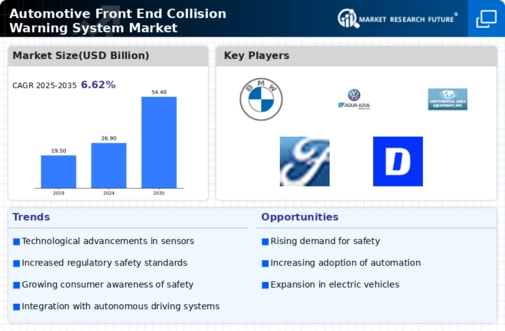Regulatory Mandates
Regulatory bodies are playing a crucial role in shaping the Automotive Front End Collision Warning System Market. Governments worldwide are implementing stringent safety regulations that require the inclusion of advanced safety features in new vehicles. For example, the European Union has mandated that all new cars must be equipped with collision warning systems by 2022. Such regulations not only promote consumer safety but also drive manufacturers to invest in advanced collision warning technologies. This regulatory push is expected to significantly increase the adoption of these systems, thereby expanding the market and encouraging innovation among automotive manufacturers.
Insurance Incentives
Insurance companies are increasingly recognizing the value of advanced safety features, including those found in the Automotive Front End Collision Warning System Market. Many insurers offer premium discounts for vehicles equipped with collision warning systems, as these technologies are associated with a lower risk of accidents. This trend not only incentivizes consumers to choose vehicles with such systems but also encourages manufacturers to incorporate these features into their designs. As the insurance industry continues to promote safety technologies, the market for collision warning systems is expected to expand, driven by both consumer choice and financial incentives.
Consumer Safety Awareness
There is a growing awareness among consumers regarding vehicle safety, which is significantly influencing the Automotive Front End Collision Warning System Market. As accidents and fatalities continue to be a concern, consumers are increasingly seeking vehicles equipped with advanced safety features. Surveys indicate that a substantial percentage of potential car buyers prioritize safety technologies when making purchasing decisions. This heightened awareness is prompting manufacturers to enhance their offerings, leading to a surge in the development and integration of collision warning systems. Consequently, the market is likely to experience sustained growth as consumer demand for safer vehicles continues to rise.
Technological Integration
The integration of advanced technologies into vehicles is a primary driver for the Automotive Front End Collision Warning System Market. Innovations such as artificial intelligence, machine learning, and sensor technologies enhance the effectiveness of collision warning systems. For instance, the incorporation of radar and camera systems allows for real-time data processing, improving the accuracy of warnings. As vehicles become increasingly equipped with these technologies, the demand for sophisticated collision warning systems is likely to rise. The market is projected to grow at a compound annual growth rate of approximately 10% over the next five years, indicating a robust trend towards enhanced vehicle safety features.
Market Competition and Innovation
The competitive landscape of the automotive industry is a significant driver for the Automotive Front End Collision Warning System Market. As manufacturers strive to differentiate their products, there is a continuous push for innovation in safety technologies. Companies are investing heavily in research and development to create more effective and reliable collision warning systems. This competition fosters an environment where advancements in technology are rapidly adopted, leading to improved system performance and consumer satisfaction. The ongoing race to enhance vehicle safety features is likely to propel market growth, as manufacturers seek to meet the evolving expectations of consumers and regulatory bodies.


















Leave a Comment